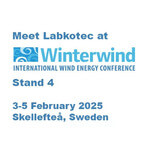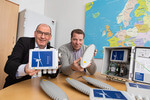08/17/2011
Africa - 22nd largest African country to erect continent's largest wind farm
African economies, led by East African region, are emerging as the world’s clean energy powerhouses, with government and investors putting money into solar power, wind energy and geothermal power to cushion against rising oil prices.
In 2010, Africa accounted for the greatest increase in renewable energy investments among developing regions, excluding the three mega-economies of China, India and Brazil, a new United Nations Environment Programme (Unep) report shows.
Over-reliance on hydro dams for electricity in regional economies has often led to blackouts when rains fail, and growing demand has stretched the infrastructure of state utility firms.
Kenya, Uganda and Tanzania are currently operating on power rationing schedules, hurting manufacturers and piling pressure on their vulnerable economies.
The Unep report, Global Trends in Renewable Energy Investment 2011, shows total investment on the continent more than quadrupled last year, surging from $750 million in 2009 to $3.6 billion in 2010.
In Kenya, investment has been broad-based across the clean technologies: wind turbines, geothermal power, solar power and biofuels. The report states that in Kenya, “investment rose from virtually zero in 2009 to more than $1.3 billion, including funding for wind power, geothermal energy and small hydro capacity of 724MW, and for 22 million litres per year of ethanol production.”
Geothermal stands out as the most promising clean energy venture in the country. In 2009, local electricity generation company Kengen raised $200 million through a public infrastructure bond offer to develop alternative energy.
In April, the company secured an $82 million loan from Germany’s development bank Kfw to build additional units at its Olkaria geothermal project.
The company, which generates 70 per cent of Kenya’s power needs, with nearly two-thirds of this coming from hydro sources, has also ventured into wind energy which provides 5.5 MW of electricity, a figure expected to increase to 15.5MW next year.
The decision to deliberately pursue a green agenda is expected to start paying dividends next year, when the company will be paid the first tranche of its carbon credits amounting to $3.3 million from the World Bank, for its development of the geothermal Olkaria II Unit 3 that generates 35MW.
Under the 2005 Kyoto Protocol, developed countries pay developing nations money under agreed terms for projects that reduce greenhouse gases. This is known as carbon credit trading.
Most of Kengen’s geothermal, hydropower and combined-cycle projects qualify for this credit trading as they generate less or no carbon dioxide at all compared with fossil fuels.
Tanzania is also making major strides towards clean energy with the Songo Songo gas-to-electricity project, which exploits natural gas reserves in the Songo Songo gas fields off the coast of Tanzania. The gas is then transported via a 225 kilometre pipeline to Dar es Salaam, where it replaces diesel in the generation of 180MW of electricity for the national grid, as well as in powering at least 30 industrial plants.
According to the Tanzania Electricity Supply Company (Tanesco), Swedish firm Siemens Energy is expected to supply three new turbines to the Ubungo power plant, powered by natural gas from Songo Songo. Tanzania’s government will finance 15 per cent of the $124.8 million project, with 85 per cent being provided by HSBC Bank of Norway under a loan agreement.
Uganda is investing heavily in hydropower, to move the country away from dependence on Independent Power Producers who rely on diesel for generation, which contributes significantly to the country’s carbon footprint. The Bujagali hydropower project on the Nile river, an $860 million project owned by Industrial Promotion Services (Kenya) Ltd and SG Bujagali Holdings Ltd, an affiliate of Sithe Global Power, LLC (USA), is expected to inject its first 50MW into the national grid by October this year.
Government funding is also expected to foot the $1.3 billion bill for the 600MW Karuma hydropower plant in northwestern Uganda, with more investments expected in mini hydropower projects, including an 18MW mini hydro power plant on the River Mpanga, as well as other projects in Ishasha (6MW), Nyagak (5MW) and Buseruka (9MW).
In Rwanda, ContourGlobal, a power development company, secured an investment guarantee in May from the Multilateral Investment Guarantee Agency (MIGA), to support the $140 million KivuWatt project, which will extract hazardous methane gas dissolved in the waters of Lake Kivu, and process the gas to generate up to 100MW of power. This should both boost Rwanda’s power generation capacity and possibly position Rwanda as a net power exporter to Uganda and the Democratic Republic of Congo.
As businesses continue to grapple with high fuel prices, smaller enterprises are also turning to clean energy to reduce the cost of doing business and remain competitive. In Uganda, solar energy is being used as an alternative to fossil fuels in agricultural processing.
Masaka Organic Producers, for instance, uses solar powered systems to dry fruits and vegetables that are then packaged and exported. The company has been supported by E+Co, a global investor in clean energy solutions, which put $100,000 into the business as working capital.
E+Co has also invested $350,000 in Zara Solar, which sells solar home systems to rural homes in Mwanza, Tanzania. Established in 1998, Zara has sold over 10,000 solar home systems to date, offsetting an estimated 5,000 tonnes of carbon dioxide emissions.
For more information on this article or if you would like to know more about what www.windfair.net can offer, please do not hesitate to contact Trevor Sievert at ts@windfair.net
www.windfair.net is the largest international B2B Internet platform – ultimately designed for connecting wind energy enthusiasts and companies across the globe!
In 2010, Africa accounted for the greatest increase in renewable energy investments among developing regions, excluding the three mega-economies of China, India and Brazil, a new United Nations Environment Programme (Unep) report shows.
Over-reliance on hydro dams for electricity in regional economies has often led to blackouts when rains fail, and growing demand has stretched the infrastructure of state utility firms.
Kenya, Uganda and Tanzania are currently operating on power rationing schedules, hurting manufacturers and piling pressure on their vulnerable economies.
The Unep report, Global Trends in Renewable Energy Investment 2011, shows total investment on the continent more than quadrupled last year, surging from $750 million in 2009 to $3.6 billion in 2010.
In Kenya, investment has been broad-based across the clean technologies: wind turbines, geothermal power, solar power and biofuels. The report states that in Kenya, “investment rose from virtually zero in 2009 to more than $1.3 billion, including funding for wind power, geothermal energy and small hydro capacity of 724MW, and for 22 million litres per year of ethanol production.”
Geothermal stands out as the most promising clean energy venture in the country. In 2009, local electricity generation company Kengen raised $200 million through a public infrastructure bond offer to develop alternative energy.
In April, the company secured an $82 million loan from Germany’s development bank Kfw to build additional units at its Olkaria geothermal project.
The company, which generates 70 per cent of Kenya’s power needs, with nearly two-thirds of this coming from hydro sources, has also ventured into wind energy which provides 5.5 MW of electricity, a figure expected to increase to 15.5MW next year.
The decision to deliberately pursue a green agenda is expected to start paying dividends next year, when the company will be paid the first tranche of its carbon credits amounting to $3.3 million from the World Bank, for its development of the geothermal Olkaria II Unit 3 that generates 35MW.
Under the 2005 Kyoto Protocol, developed countries pay developing nations money under agreed terms for projects that reduce greenhouse gases. This is known as carbon credit trading.
Most of Kengen’s geothermal, hydropower and combined-cycle projects qualify for this credit trading as they generate less or no carbon dioxide at all compared with fossil fuels.
Tanzania is also making major strides towards clean energy with the Songo Songo gas-to-electricity project, which exploits natural gas reserves in the Songo Songo gas fields off the coast of Tanzania. The gas is then transported via a 225 kilometre pipeline to Dar es Salaam, where it replaces diesel in the generation of 180MW of electricity for the national grid, as well as in powering at least 30 industrial plants.
According to the Tanzania Electricity Supply Company (Tanesco), Swedish firm Siemens Energy is expected to supply three new turbines to the Ubungo power plant, powered by natural gas from Songo Songo. Tanzania’s government will finance 15 per cent of the $124.8 million project, with 85 per cent being provided by HSBC Bank of Norway under a loan agreement.
Uganda is investing heavily in hydropower, to move the country away from dependence on Independent Power Producers who rely on diesel for generation, which contributes significantly to the country’s carbon footprint. The Bujagali hydropower project on the Nile river, an $860 million project owned by Industrial Promotion Services (Kenya) Ltd and SG Bujagali Holdings Ltd, an affiliate of Sithe Global Power, LLC (USA), is expected to inject its first 50MW into the national grid by October this year.
Government funding is also expected to foot the $1.3 billion bill for the 600MW Karuma hydropower plant in northwestern Uganda, with more investments expected in mini hydropower projects, including an 18MW mini hydro power plant on the River Mpanga, as well as other projects in Ishasha (6MW), Nyagak (5MW) and Buseruka (9MW).
In Rwanda, ContourGlobal, a power development company, secured an investment guarantee in May from the Multilateral Investment Guarantee Agency (MIGA), to support the $140 million KivuWatt project, which will extract hazardous methane gas dissolved in the waters of Lake Kivu, and process the gas to generate up to 100MW of power. This should both boost Rwanda’s power generation capacity and possibly position Rwanda as a net power exporter to Uganda and the Democratic Republic of Congo.
As businesses continue to grapple with high fuel prices, smaller enterprises are also turning to clean energy to reduce the cost of doing business and remain competitive. In Uganda, solar energy is being used as an alternative to fossil fuels in agricultural processing.
Masaka Organic Producers, for instance, uses solar powered systems to dry fruits and vegetables that are then packaged and exported. The company has been supported by E+Co, a global investor in clean energy solutions, which put $100,000 into the business as working capital.
E+Co has also invested $350,000 in Zara Solar, which sells solar home systems to rural homes in Mwanza, Tanzania. Established in 1998, Zara has sold over 10,000 solar home systems to date, offsetting an estimated 5,000 tonnes of carbon dioxide emissions.
For more information on this article or if you would like to know more about what www.windfair.net can offer, please do not hesitate to contact Trevor Sievert at ts@windfair.net
www.windfair.net is the largest international B2B Internet platform – ultimately designed for connecting wind energy enthusiasts and companies across the globe!
- Source:
- Online Editorial www.windfair.net / Author: Christina Mungei
- Author:
- Posted by Trevor Sievert, Online Editorial Journalist
- Email:
- ts@windfair.net
- Link:
- www.windfair.net/...
- Keywords:
- wind, wind energy, wind turbine, rotorblade, awea, ewea, wind power, suppliers, manufacturerstrevor sievert























